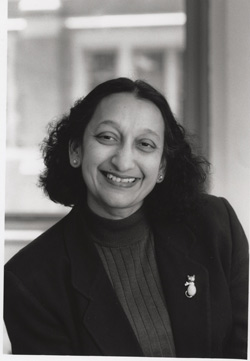Chatterji Part of Prestigious Committee Recommending Major Change in Thinking About Obesity Studies
Professor Chatterji Part of Prestigious IOM Committee that Recommends Major Change in How Policy-makers Think about Evidence to Combat Obesity
The framework, contained in a report entitled “Bridging the Evidence Gap in Obesity Prevention: A framework to Inform Decision Making,” was released on April 23.
In an interview, Chatterji said she “was honored” to be chosen as a member of the highly selective committee—which included well known obesity prevention scholars, doctors, medical researchers, state legislators, economists and public policy experts—because of her specializations in research study designs. Chatterji was one of two methodologists on the committee. The committee released its report only after its 16 members came to consensus.
“Federal policies on evidence–based practices in public health and education sectors borrow from ideas in evidence-based medicine, which was the first to promulgate the notion that randomized experiments are the very best means for gathering evidence on effective therapies,” Chatterji said. “This long-standing tradition has influenced how research has been conducted and how researchers and evaluators are trained in the health fields, education and the social sciences at large. It has also influenced the current evidence pool that is available to policy-makers and practitioners responsible for making important decisions about programs and policies every day. When programs and policies involve complex systems of variables, including personal, social and environmental factors, such as individual values and community culture, their effects on large populations simply cannot be properly captured with randomized controlled trials alone. There are just too many things happening.”
Instead, the IOM’s framework suggests an interdisciplinary approach for choosing from a range of research methods and study designs. “Using the framework,” the committee states in its report summary, “involves innovative approaches to generating, identifying, evaluating, and compiling evidence—taking the broad, transdisciplinary perspective.
“Overall,” the committee’s summary states, “the framework encourages decision makers and researchers to look at obesity from a systems perspective, as a complex, population-based health problem that has many contributing factors.” Chatterji added that the committee’s recommendations are for building and using a broad evidence base, using formal, research-based evidence as well as other credible forms of evidence, for example, expert opinion released by respected national agencies or groups.
The IOM committee recommended that all stakeholders in obesity research—government and private funders, research institutions and educators, journal editors, and professional organizations—need to incorporate systems thinking into the research process and the ways in which research is used when addressing population-based health problems.
They also need to apply what the committee calls the L.E.A.D. framework for decision making. After specifying the questions that they wish to answer (for example, Do healthier food options in school cafeterias result in lower obesity rates?), decision makers applying the framework would need to: Locate evidence, Evaluate the evidence for quality and relevance, Assemble the evidence taking into consideration the proposed uses, and then use the evidence to inform Decisions.
Other recommendations made by the committee include:
- Building a system of resources (such as people, compendiums of knowledge, registries of implementation experience) to support evidence-based public policy, decision making, and research for addressing complex health challenges, such as obesity prevention;
- Establishing broader but rigorous standards for evidence quality;
- Supporting the generation of evidence, taking into account the degree to which the findings can be generalized, and related implementation issues at every stage, from conception through publication.
- Encouraging collaboration among researchers in a variety of disciplines so as to utilize a full range of research designs; and
- Communicating, disseminating, evaluating and refining the L.E.A.D. framework.
TC Deputy Provost John Allegrante, who has been studying changes in the prevalence of overweight and obese children and adolescents in
Chatterji said she hoped that the framework would change the way evidence is used and generated in the obesity area, as well as influence how evidence is viewed in other fields like education that also aim to affect populations on a large scale. “The parallels between public health and education are numerous,” she said. “In both, we face the need to study complex social interventions in their natural environments and must think outside the box in our search for suitable research designs and tools.”
More information, including a summary and full text of the IOM report, may be obtained at: http://www.iom.edu/Reports/2010/Bridging-the-Evidence-Gap-in-Obesity-Prevention-A-Framework-to-Inform-Decision-Making.aspx
Published Monday, May. 3, 2010
